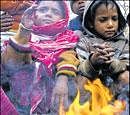
Beyond its Silicon City and Garden City images, the cosmo crowd of Bangalore has earned the youngest metro a peppy, young tag: “A place to chill out.” The trendy pubs were reason enough to certify that image. But this winter, the chill was too cold for many Bangaloreans to step out, a scene that had many old tongues wagging whether the climate change had finally transformed the City’s weather decisively.
This perceptible change was brought to the fore tellingly on December 23, 2010, when the minimum temperature in the City dipped to three degrees Celsius. At the HAL Airport, the temperature was six degrees. These were lower than the average temperature recorded during winter over the past 50 years.
At another extreme, the scorching summers of recent years have taken the sheen off
Bangalore’s once-famed salubrious, cool weather. The weather that attracted a middle class migration from across the country has been changing for the worse. Long-time residents were the first to sense it. This winter’s chilly nights only reinforced that perception, even if not fully supported by hard facts.
Here are some valid observations by an expert on climate change, Prof N H Ravindranath from the Indian Institute of Science (IISc). “In tune with global warming, Bangalore’s temperature, too, has increased. I won’t say it has increased too much, but by a few decimals,” he notes.
Fortunately, the weather change, he says, is still under control. “The extreme changes in weather as seen in European countries are not found in Bangalore.”
Urban heat island effect
Yet, the scientists have an explanation for the perceptible rise in summer temperatures. “In scientific terms, we call the increase in temperature the urban heat island effect,” says Ravindranath. “Tar and cement roads, concrete buildings, infrastructure projects, lack of greenery and pollution are some of the contributors to the change in the weather pattern,” he explains.
The big spurt in the City’s population has invariably been a factor. Over the last 10 years, it doubled from nearly 50 lakh in 2001 to close to 90-95 lakh in 2010, forcing the civic authorities to go for an extensive infrastructure development. Thousands of trees that moderated Bangalore’s climate had to make way, the latest fellings being designed to facilitate the widening of the Jayamahal Road and the Suranjan Das Road. Seen through the lens of development, felling trees is no longer considered taboo.
Rising pollution due to an explosive growth in the number of vehicles has been another critical factor that has contributed to the change in the weather and increasing health problems. The apparent change for the worse in air quality has made people more sensitive to even small change in climatic conditions.
Some statistics put the City’s growth in perspective. The number of buses in Bangalore rose from 5,000 in 2001 to 35,000 in 2011. The total number of vehicles increased from 9-10 lakhs in 2001 to about 26 lakh in 2010. About 8,000 to 10,000 trees were sacrificed to rid the city of regular traffic jams.
Lakes were either encroached upon or were polluted to the extent that they were later covered up and turned into housing colonies in the last 50 years. Many lakes in the City act as junctions of sewer drains. The three lifeline rivers of Bangalore — Arkavathi, Vrushabhavathi and Hemavathi — are now filthy stormwater drains.
The City’s environment is thus apparently on a downward slide. Yet, the weather change is not perceptible enough to be called alarming. As the Director of Karnataka Natural Disaster Monitoring Centre, Dr V S Prakash, put it, “The 70-80 years of records we have are too scanty a data to come to a conclusion.”
The consequences of depleting tree cover, water bodies and the rise in the size of the concrete jungle may not be felt immediately. Eco-watchers say the implications will start showing through variations in weather in the near future. The speed of such climate change would be much faster than the pace at which people adapt to the changes.
However, the Director of the Bangalore Meteorology Department, B Puttanna, is not convinced by that argument. “It is a common practice that whenever sensitive people find a slight change in the weather, they react immediately. But the data available with us show that there is no substantial change in the weather in the last 100 years,” he says.
He concedes, however, that Bangalore’s weather has been at least two-degree Celsius higher than the semi-urban or rural areas on the outskirts of the City.
Data available with the Meteorology Department indicate that in the last 10 years, the highest maximum temperature recorded was on January 24, 2000, when the mercury touched 32.8 degrees Celsius. The lowest all-time minimum temperature was recorded on January 13, 1884, when the mercury dipped to 7.8 degree Celsius.
The “pleasant” factor
Whatever the statistics, Bangaloreans no longer feel the weather is “pleasant” anymore. The pleasing climate of yore, which led many to migrate to the City from other parts of the country known for their extreme summers and winters, is now a memory tinged with nostalgia. In relative terms, Bangalore’s summers are perceived as hotter and winters colder. The man-made eco-disasters triggered in the name of development is not doing anything to change that perception.
